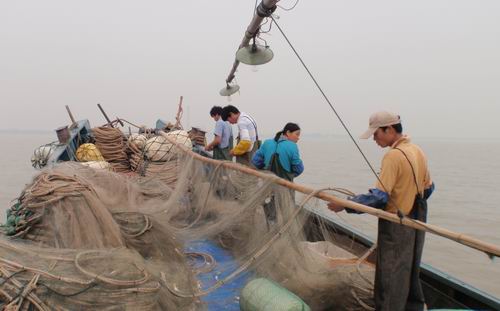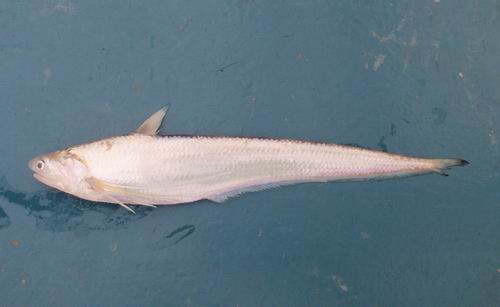
Newsroom
IHB's suggestion of Cutting Down the Fishing Period of Coilia ectenes adopted by Bureau of Fishery Administration of China
Since 2002, the Bureau of Fishery Administration of China began to implement the system of Special Licenses for Coilia ectenes Fishing. Every year’s fishing period of Coilia ectenes was set from February 20 to April 30 in Yangtze Estuary.

Fishermen draw in a net to catchCoilia ectenesin the Yangtze Estuary.
The Research Group of Environmental Biology of Fishes at Institute of Hydrobiology, Chinese Academy of Sciences (IHB), led by Prof. XIE Songguang, has been persistent on studying Spatio-temporal variation in fishing yield, size composition and price structure of Coilia ectenes in the Estuary of Yangtze River, ever since 2006. They found that only few or no Coilia ectenes could becaught during February 20 and March 1. The peak time was from April 15 to 30 when the catches of Coilia ectenes accounted for 50% of the total catch in the whole fishing season. However, mainly age-1 individuals formed this catch which only fetch a low price. The sales volume thus accounts for only 10% of that of the whole year. Prof. Xie and his colleagues’ discovery prove that cutting down of fishing period for Coilia ectenes will have little influence on the fishing profits, yet the fishing intensity can be reduced to half. In the meantime, reducing the fishing of Coilia ectenes juveniles can increase the number of Coilia ectenes adults which will be conserved for the fishing season of next year. In the long run, the benefits of the fishermen will not be impaired, but enhanced.
Prof. Xie and his colleagues reported their discovery to the Bureau of Fishery Administration of China. On January 29, 2010, the Bureau of Fishery Administration of China issued a circular to strengthen the fishing regulations of Coilia ectenes. In the circular, IHB’s suggestion to cut down the fishing period of Coilia ectenes was adopted. The fishing period of Coilia ectenes is now re-set to March 1 to April 20. The circular also requires the number of granted fishing licenses to be reduced by 10% within three years. This is the first time that fishing regulations of Coilia ectenes has been adjusted since 2002, when special administrative policy was applied to the fishing of Coilia ectenes.

Coilia ectenes
The anadromous fish Coilia ectenes is renowned as one of the three delicious fishes in the Yangtze. The other two are Tenualosa reevesii and Tetraodon fluviatils Hamilton. The life history of these three species are almost similar. Tenualosa reevesii is now nearly disappeared and the natural population of Tetraodon fluviatils Hamilton also decreases rapidly, artificial reproduction has been adopted to restore its natural population. Coilia ectenes is the only living anadromous fish in the lower reaches of Yangtze River that can be caught in a regular period of a year, but its natural population also showed signs of sharp decline. This fish could previously migrate to Dongting Lake (a large shallow lake in Hunan province) and Xiangjiang River (the largest river in Hunan province and one of the largest tributaries of Yangtze River), but now they can only migrate to the lower reaches of the mouth of Poyang Lake (China’s largest freshwater lake in Jiangxi province). Besides, the fish manifests the characteristics of delay in the migratory season, small in size and young in age. If no measures are taken, Coilia ectenes is feared to have the same fate of Tenualosa reevesii or Tetraodon fluviatils Hamilton.
Prof. Xie’s Group also follows up the overfishing issue in the middle and lower reaches of Yangtze River and river-connecting lakes shortly after the fishing ban period. The results of such studies with first hand data are expected to be useful for the departments of fishery administration to take appropriate management measures to regulate and control the devastating utilization of fishery resources.